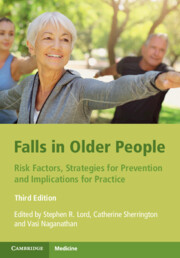Book contents
- Falls in Older People
- Falls in Older People
- Copyright page
- Contents
- Preface
- Contributors
- Part I Epidemiology and Risk Factors for Falls
- Part II Strategies for Prevention
- 16 Exercise to Prevent Falls
- 17 Volitional and Reactive Step Training
- 18 Cognitive-Motor Interventions and Their Effects on Fall Risk in Older People
- 19 Cognitive Behavioural Interventions for Addressing Fear of Falling and Fall Risk
- 20 The Medical Management of Older People at Risk of Falls
- 21 Fall Prevention Interventions for People with Visual Impairment
- 22 Footwear, Orthoses, Walking Aids, Wearable Technology, and Restraint Devices for Fall Prevention
- 23 Environmental Interventions to Prevent Falls at Home and in the Community
- 24 Fall Injury Prevention: Hip Protectors and Compliant Flooring
- 25 Multi-Factorial Fall Prevention Strategies: Where to Next?
- 26 Fall Prevention in Hospitals
- 27 Fall Prevention in Residential Aged Care Facilities
- Part III Implications for Practice
- Index
- References
18 - Cognitive-Motor Interventions and Their Effects on Fall Risk in Older People
from Part II - Strategies for Prevention
Published online by Cambridge University Press: 04 November 2021
- Falls in Older People
- Falls in Older People
- Copyright page
- Contents
- Preface
- Contributors
- Part I Epidemiology and Risk Factors for Falls
- Part II Strategies for Prevention
- 16 Exercise to Prevent Falls
- 17 Volitional and Reactive Step Training
- 18 Cognitive-Motor Interventions and Their Effects on Fall Risk in Older People
- 19 Cognitive Behavioural Interventions for Addressing Fear of Falling and Fall Risk
- 20 The Medical Management of Older People at Risk of Falls
- 21 Fall Prevention Interventions for People with Visual Impairment
- 22 Footwear, Orthoses, Walking Aids, Wearable Technology, and Restraint Devices for Fall Prevention
- 23 Environmental Interventions to Prevent Falls at Home and in the Community
- 24 Fall Injury Prevention: Hip Protectors and Compliant Flooring
- 25 Multi-Factorial Fall Prevention Strategies: Where to Next?
- 26 Fall Prevention in Hospitals
- 27 Fall Prevention in Residential Aged Care Facilities
- Part III Implications for Practice
- Index
- References
Summary
Many studies have now shown that both physical and cognitive factors are important in fall risk. In accordance with the common-cause theory of cognitive ageing, which states that age-related declines in cognitive, sensory, and motor functioning are attributed to a common neurobiological mechanism, there is evidence of shared variance between sensorimotor and cognitive age-related changes. Indeed, cognitive, sensory, and motor inter-relationships strengthen with age [1]. It is, therefore, of little surprise that parameters of the postural control system are influenced by the cognitive demand of a task, particularly in older people. Undertaking daily tasks, such as maintaining upright posture and safely navigating complex environments, requires adequate sensory perception, cognitive integration, and subsequent motor adjustments [2], with increased cognitive processing required with aging [3]. Furthermore, many daily activities require the handling of two or more simultaneous tasks, such as walking while talking, carrying a basket with laundry while navigating the stairs, or crossing a busy road safely [4]. Older people appear not to be able to process multiple tasks as quickly and/or as well as younger adults and such impairments have been linked to falls in older people [5]. Figure 18.1 displays a hypothetical model of how the sensory, cognitive, and motor domains are inter-linked and how these factors and interactions might contribute to falls.
- Type
- Chapter
- Information
- Falls in Older PeopleRisk Factors, Strategies for Prevention and Implications for Practice, pp. 287 - 310Publisher: Cambridge University PressPrint publication year: 2021
References
- 1
- Cited by



